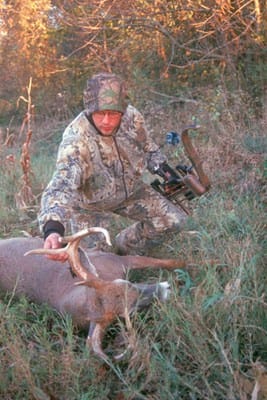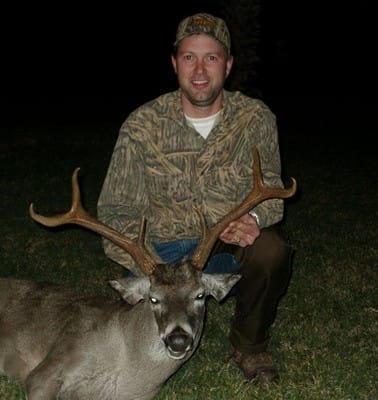
Grunts, bleats, and rattles are elemental sounds in the grand scheme of things, regardless of the creature making the sounds. However, there might be a bit more to when these sounds, or more precisely, a combination of these sounds might be best employed in the pursuit of America’s favorite big game animal, the whitetail deer.
A veteran both of the field and the art that is game calling, Quaker Boy’s Chris Kirby makes this simplistic statement first rattle out of the box when the topic turns to calling today’s whitetail.
“There really is no ‘right or wrong, just common sense and observation,” said Kirby.
That said, what would Kirby suggest in terms of calling strategies dictated by the calendar? The deer’s calendar, that is.
Pre-rut
“During the pre-rut, you have bucks that are rubbing trees, working ground scrapes,” Kirby said. “They’re looking for does, finding does, and fighting for territory and dominance. This is all before the rut ever comes into play. Now, I do a lot of grunting and a fair amount of rattling during that pre-rut because that’s what’s happening naturally in terms of deer activity. There’s not a lot of does in estrus at that point, if any, but the bucks are still fighting with each other for dominance.”
Peak Rut
“With the peak of the rut, you have does in estrus, and that’s what those bucks are looking for,” Kirby said. “Now, I’ll do a lot more bleating with some bleat/grunt combinations, because that’s what’s happening naturally. If you’re in that buck’s core area, turn over that Bleat-in-Heat and follow that up with two or three quick tending grunts. That gives deer the illusion that ‘Hey, there’s a doe ready to be bred in the territory I’ve been fighting for, and there’s another buck chasing one of my does.’ Chances are he’s going to come in to investigate.”
Post-rut
“Post-rut, I go back to a lot of bleating, just for those bucks still looking for that one receptive doe. Now, I’ll downplay the grunts because he’s so worn down, he may not come in to fight. Breed? Yes. Fight? Maybe not.”
Another calling tactic which can be effective at any time during the season is trolling. Like blind-calling for wild turkeys, trolling for deer is very simply defined as (1) placing oneself in an area of known deer activity, and (2) calling, be that grunting, bleating, rattling, or a combination of the three, intermittently in hopes of catching and hanging onto the ear of a passing buck.
However, according to Kirby, there’s been a change in the way that many modern archers view this strategy. Traditionally trolling for deer was very similar to blind-calling for gobblers in that the one thing a caller constantly had to be cognizant of was over-calling. Grunt or bleat, and wait 15 minutes was the norm. Then grunt and bleat, and wait 15 minutes. Today, however, there are some new thoughts on this age-old technique.
“Trolling every 15 or 20 minutes? That’s not trolling,” said Kirby. “Calling every three to four minutes? Now that’s trolling. I mean, when you’re trolling bait behind a boat, you’re trolling the whole time. True trolling, to me, is constant. Turn that Bleat-in-Heat over. Grunt. Get those sounds out there and catch that deer that’s in earshot and have him come in to investigate.”
Kirby went on to explain that deer move so fast through the woods that if you wait 15 minutes between calls, the buck could have moved through your little window of opportunity where he actually could hear you. He’s come and gone and the call’s no longer effective.
Calling—The Implements
Selecting a deer call is often a matter of personal preference. Design quality and sound authenticity are common denominators. But do these variables create confusion? Not necessarily, for as the following glossary suggests, the choice is more often than not dictated by what the caller wishes to achieve.
Monotone Grunt Tubes: They produce a grunt, which can be a young deer, an older deer, or a middle-aged deer, depending upon the type of call. The caller can control variables such as volume and call duration. Expandable, accordion-like bellows can provide some variation in pitch.
Variable Tone Grunt/Bleat Tubes: These calls are capable of reproducing both grunts and bleats, and at different pitches. All involve some method—a push-pin, o-ring, dial, or simple finger pressure—of changing the relationship between the reed or reeds and the sound board.

Bleat Tubes: Today, bleats are most often a by-product of the variable tone tubes. However, bleat-specific calls are available from several of the nation’s largest manufacturers.
Bleat Cans: Quaker Boy’s original Bleat-in-Heat and their higher-pitched Bleat-in-Heat II are two of the most common examples. Hunters simply invert the can, and presto, perfect bleats every time.
Electronic Calls: New to archers in the 21stCentury is a breed of electronic deer calling units. Press a button, and out of a small 15-watt, 8-ohm speaker comes a digitally mastered bleat. Or an estrus bleat, tree rub, or snort-wheeze. What is the plus side? The learning curve here is almost non-existent. What are the negatives? For some, there’s the price, which can run from $150 to $220, depending upon the source. Too, electronic calls aren’t legal in all states. Still, where regulatory restrictions and pocketbooks aren’t an issue, electronics are certainly worth a look.
Contact
Quaker Boy Game Calls; www.quakerboygamecalls.com







